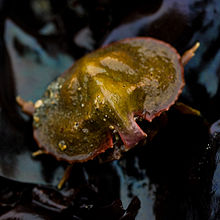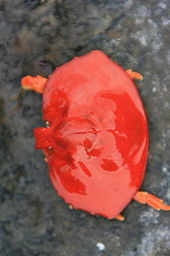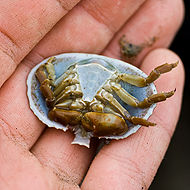- Cryptolithodes sitchensis
-
Cryptolithodes sitchensis 
Scientific classification Kingdom: Animalia Phylum: Arthropoda Subphylum: Crustacea Class: Malacostraca Order: Decapoda Infraorder: Anomura Family: Lithodidae Genus: Cryptolithodes Species: C. sitchensis Binomial name Cryptolithodes sitchensis
Brandt, 1853 [1]Cryptolithodes sitchensis, variously known as the umbrella crab, Sitka crab or turtle crab,[2] is a species of lithodid crustacean native to coastal regions of the northeastern Pacific Ocean, ranging from Sitka, Alaska to Point Loma, California.[3] Its carapace extends over its legs such that when it pulls in its legs, it resembles a small stone. It lives in rocky areas from the low intertidal to depths of 17 metres (56 ft).[3]
Contents
Description
Cryptolithodes sitchensis has a half-moon shaped carapace that extends over all of its eight walking legs and two cheliped, giving them their common names of turtle crab, umbrella crab or helmet crab. The carapace can be 5–10 centimetres (2.0–3.9 in) at the adult stage and has scalloped edges. This carapace ranges from neutral sandy colors to bright oranges, reds, and purples.[4]:192, 255 The rostrum extends forwards from the carapace, gradually widening before ending abruptly. From above, only the eyes and second antennae are visible. The ventral side is commonly white in color, and the abdomen is protected my multiple hard plates that lack raised margins.[4]:407 The chelipeds are smooth.The fifth pair of walking legs are located at the posterior, and are difficult to distinguish.[5]
Range
Cryptolithodes sitchensis can be found from southern Alaska to southern California. They live within 18 metres (59 ft) of the intertidal zone along the exposed coasts of the Pacific Ocean.[5] Intertidal species of Lithodidae prefer habitats of cooler temperatures ranging from 0–25 °C (32–77 °F) and temperatures of 16 °C (61 °F) during larval development. This causes a restriction on their distribution as water temperatures change due to global warming.[6]
Identification
The distinguishing characteristic between C. sitchensis and C. typicus is that C. sitchensis has a rostrum that is wider distally than proximally, while the opposite is found in C. typicus. Also, C. typicus has raised margins of the abdominal segments while C. sitchensis does not.[4]:407
Life history
The larval development of C. sitchensis is characteristic of having six tergites at the megalopal stage. Upon reaching the adult stage the first and second abdominal segments have fused and the sixth tergite and telson are whole. Male and female C. sitchensis have symmetrical abdomens, yet females have a greater number of accessory plates on the left side of the third tergite.[7]
Natural history
Cryptolithodes sitchensis may be hard to spot due to its rough, rock-like exterior, but is easily caught due to its slow movements. Found most commonly in the intertidal zone, C. sitchensis feeds on coralline algae. This may be the reason for the diverse colorations of its carapace to camouflage with its surroundings.[8]
Threats
Natural predators of C. sitchensis include larger marine invertebrates like octopus, as well as sea birds, and marine mammals like otters.
A major threat to C. sitchensis in Southern California is deforestation and its effects on the giant kelp forests around the Channel Islands National Park. The giant kelp forests of Macrocystis pyrifera form a protective canopy, fostering the ideal temperature for various species that are temperature sensitive, such as C. sitchensis, and the growth of macroalgae and coralline algae needed for their survival.[9]
References
External identifiers for Cryptolithodes sitchensis EOL 343208 ITIS 97953 NCBI 174327 Also found in: Arctos - ^ "Cryptolithides sitchensis". Integrated Taxonomic Information System. http://www.itis.gov/servlet/SingleRpt/SingleRpt?search_topic=TSN&search_value=97953.
- ^ "Cryptolithodes sitchensis". ZipCode Zoo. http://zipcodezoo.com/Animals/C/Cryptolithodes_sitchensis/. Retrieved November 14, 2009.
- ^ a b Gregory C. Jensen (1995). Pacific Coast Crabs and Shrimps. Sea Challengers. ISBN 0930118200.
- ^ a b c Eugene N. Kozloff (1993). Seashore Life of the Northern Pacific Coast. Seattle, WA: University of Washington Press.
- ^ a b Andy Lamb & Bernard Hanby (2005). Marine Life of the Pacific Northwest: A Photographic Encyclopedia of Invertebrates, Seaweeds and Selected Fishes. Harbour Publishing. pp. 313. ISBN 1550173618.
- ^ Sally Hall & Sven Thatje (2009). "Global bottlenecks in the distribution of marine Crustacea: temperature constraints in the family Lithodidae". Journal of Biogeography 36 (11): 2125–2135. doi:10.1111/j.1365-2699.2009.02153.x.
- ^ Patsy A. McLaughlin & Rafael Lemaitre (2000). "Aspects of evolution in the anomuran superfamily Paguroidea: one larval prospective" (PDF). Invertebrate Reproduction and Development 38 (3): 159–169. http://si-pddr.si.edu/dspace/bitstream/10088/7369/1/IZ_Lemaitre2000AspectsofEvolution.pdf.
- ^ Dave Cowles (2005). "Cryptolithodes sitchensis Brandt, 1853". Walla Walla University. http://www.wallawalla.edu/academics/departments/biology/rosario/inverts/Arthropoda/Crustacea/Malacostraca/Eumalacostraca/Eucarida/Decapoda/Anomura/Family_Lithodidae/Cryptolithodes_sitchensis.html. Retrieved May 11, 2010.
- ^ Michael H. Graham (2004). "Effects of Local Deforestation on the Diversity and Structure of Southern California Giant Kelp Forest Food Webs". Ecosystems 7 (4): 341–357. doi:10.1007/s10021-003-0245-6. http://www.jstor.org/stable/3658821.
External links
Categories:- King crabs
- Indo-Pacific crustaceans
- Animals described in 1853
Wikimedia Foundation. 2010.


